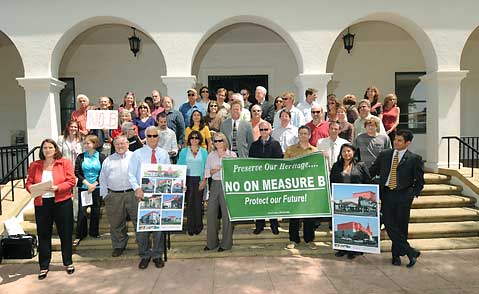New Height Limit Would Flatten City, Not Save It
No Need to Mess with 60-Foot Success

El Pueblo Viejo, our historic district, stretches along State Street from Stearns Wharf to Mission Street and along Carrillo Street from the freeway to Laguna Street, with irregular borders inside that rectangle. It includes all of our downtown.
There are folks who want to change the current 60-foot height limit for buildings in El Pueblo Viejo to 40 feet. Even though they profess to love our many architectural treasures that exceed 40 feet-buildings like the Arlington and Lobero Theaters, Trinity Episcopal Church, and the Courthouse-they believe that no future building should ever exceed 40 feet. Anything exceeding this magical number of 40 feet, they believe, is a “high rise,” and unacceptable.
The current 60-foot height limit has been in the charter since 1972. Yet, suddenly, this historic limit has become THE problem in our community while so many real problems, like gang violence, traffic and housing shortages, hardly get debated.
The proponents of a new 40-foot height limit have put the issue on the November ballot as “Measure B.” It just illustrates the old saying: “For every problem there is a solution that is both simple and wrong.” The height of buildings is but one element of design, which also includes setbacks, open space, openings, proportion, roofs, and many other factors. Design standards need to balance all of those factors, and are much better handled as part of the city’s general plan update process.
Currently, the city is updating its general plan, with extensive participation by the community. This process should and will address the issues of how high buildings should go, how much set-back and open space they need, and how many housing units they should have. And the city is updating its general plan within a framework of sustainability. These are the issues that concern most residents, but are far too complex for a single ballot initiative.
Single-issue ballot initiatives are becoming commonplace. They have become the answer to what appears to many as a failed democracy. But the unintended consequences of many of these initiatives, especially at the statewide level, are only now being felt.
What does it really mean to reduce the height of buildings in our downtown forever, or at least until a new charter amendment reverses the decision? Might it result in more building in our neighborhoods? Will it increase pressures to develop nearby agricultural lands or the Gaviota Coast?
Measure B’s proponents argue that smaller buildings are more sustainable, a claim that is both factually wrong and dangerously misleading. Furthermore, they suggest that affordable housing needs to be developed where the land is cheaper, not in our downtown. This is, by definition, encouraging sprawl!
If the rest of the world lived like we do, in our mostly low-density, single-family homes, driving almost everywhere we go, we would need six planet Earths. Think about that! It would take six planets to sustain our low scale, spread out, auto-dependent lifestyles!
We now understand that a taller building with a smaller footprint is more sustainable than a shorter and more spread-out building. This principle also applies to cities. Cities that are walkable and vital tend to have more compact and dense housing areas. The most sustainable cities in the world tend to be older cities with compact urban cores planned not for the automobile, but rather for the human condition: cities like those in the Andaluc-a region of Spain that we have modeled our community after for the last 85 years.
No one is proposing density or height beyond what works well for Santa Barbara. Our historic 60-foot height limit has worked well for the last 37 years. In that period only five buildings have been built up to 60 feet-including Paseo Nuevo and the rebuilding of the former Carrillo Hotel, now the Canary, which was originally built in 1923 to 66 feet. Seven other buildings have been built above 50 feet, including the headquarters of Santa Barbara Bank & Trust and the whimsical Ablitt’s building. The vast majority of all buildings built over the last 37 years are below 40 feet.
We have a robust and effective planning process in Santa Barbara. Any building proposed in the downtown El Pueblo Viejo goes through arduous public review at the Historic Landmarks Commission. Structures over 10,000 square feet go to the Planning Commission, a process that usually takes more than a yearoften longer. Only an exceptional project, one with strong community support, could ever be built to 60 feet. But it could just be a project that our community really needs and that becomes one of our cherished landmarks someday.
Do we want a vital downtown where people live and work and walk and bike instead of drive? Do we want to be truly sustainable? Sustainability is fundamentally about creating less impact while we are here. It is about protecting this beautiful place for future generations and not foreclosing on their options to do the same when their turn arrives.
Our future depends on the choices we make. We can limit our potential and bury our heads in the sand about being a truly sustainable city, or we can preserve our current height limit to protect our future.



